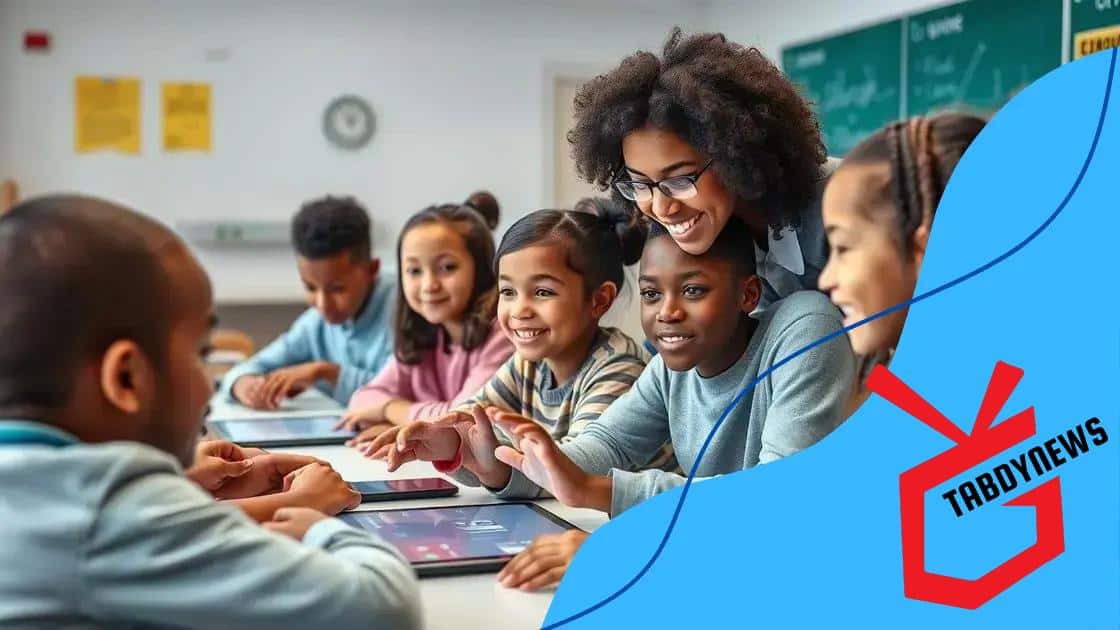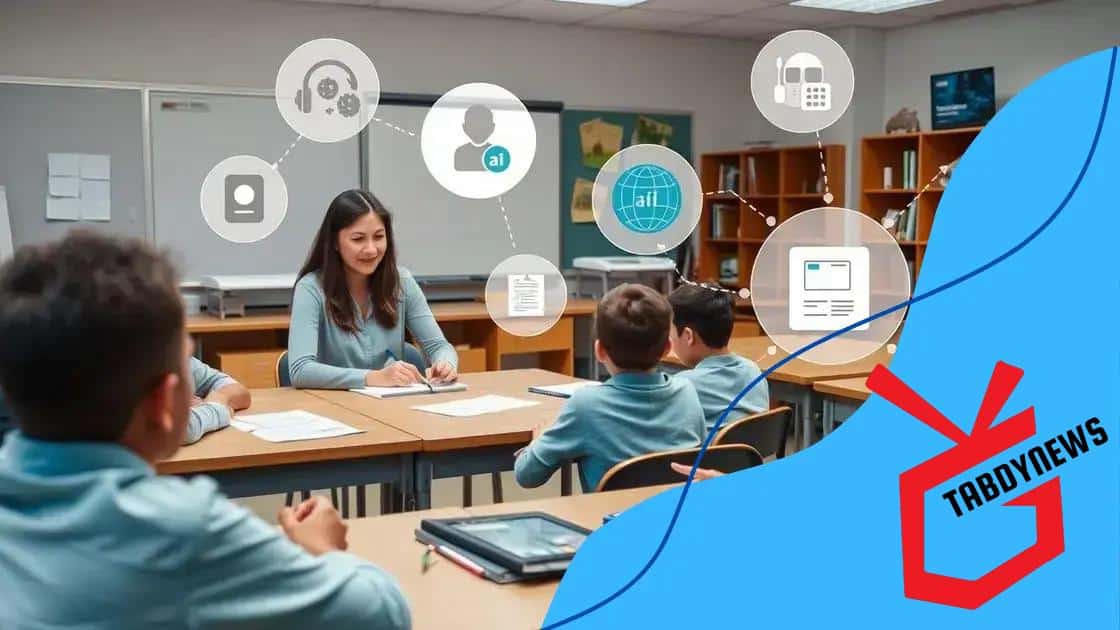AI applications in special education: transforming learning

AI applications in special education enhance personalized learning and communication, providing tools that support diverse student needs while improving engagement and facilitating collaboration in the classroom.
AI applications in special education are reshaping how educators support diverse learning needs. Have you ever wondered how technology can personalize education for every child? Let’s dive into this fascinating topic!
Understanding AI in special education
Understanding AI in special education is crucial for improving learning experiences for students with diverse needs. This technology provides tools that can enhance educational methods and materials. It allows for personalized learning, adapting resources to fit individual student requirements.
What is AI in special education?
AI refers to systems that can perform tasks that normally require human intelligence. In special education, AI can analyze how students learn and tailor educational content accordingly. This ensures that every child receives the support they need.
Benefits of AI for students with disabilities
AI can dramatically change the learning landscape for students with disabilities. Here are some benefits:
- Personalized learning pathways that match each student’s pace.
- Tools that assist with communication for non-verbal students.
- Monitoring progress through data analysis.
- Accessible educational materials that cater to various learning styles.
By utilizing AI, educators can offer more comprehensive support. AI technology allows teachers to focus on individual student needs, making learning more effective and engaging. As these tools evolve, the potential for inclusive education grows.
Additionally, AI enhances collaboration among educators. It provides them with insights about student engagement and challenges. Understanding these dynamics helps teachers create more inclusive classrooms. They can share strategies and tools that have proven successful.
Real-world applications of AI
In many schools, AI applications are already making a difference. For instance, some programs use machine learning to adapt quizzes and educational games based on student performance. This not only keeps students interested but reinforces their learning effectively.
Moreover, virtual assistants powered by AI can answer students’ questions instantly. This reduces the wait time for help and allows students to learn at their own pace.
With the ongoing development of AI, there’s a growing optimism about its role in education. The goal remains to create an environment where all learners, especially those with special needs, can thrive.
Benefits of AI for students with disabilities
There are numerous benefits of AI for students with disabilities that can transform their educational experiences. By leveraging technology, education becomes more accessible and tailored to individual needs. These advancements ensure that every student can learn effectively.
Personalized Learning Experiences
AI enables personalized learning pathways. This means learning materials and activities can adapt to each student’s unique strengths and challenges. As a result, students can progress at their own pace, enhancing their confidence and understanding.
Assistive Technology
Another significant advantage is the development of assistive technologies. These tools can support communication for students who have difficulties. Examples include:
- Speech recognition software that helps non-verbal students express themselves.
- Augmented reality tools that offer interactive learning experiences.
- Text-to-speech applications that assist with reading comprehension.
- Adaptive software that adjusts to the student’s learning style.
By integrating these tools into the classroom, teachers can create a more inclusive environment where all students feel valued.
AI also brings about improved progress tracking. Educators can use data analytics to monitor student growth. These insights allow teachers to identify areas where students may be struggling and adjust their approaches effectively.
Enhanced Engagement
Another key factor is the enhancement of student engagement. AI-driven interactive platforms can make learning more enjoyable. Games and quizzes adapted to a student’s abilities can motivate them to participate actively.
Moreover, AI tools can help build social skills in students with disabilities by facilitating communication with peers. This creates opportunities for collaboration and learning from each other.
Ultimately, the incorporation of AI in the classroom offers a brighter future for students with disabilities. By addressing their unique needs, we empower them to thrive and succeed in their educational journeys.
AI tools for educators in special education

There are numerous AI tools for educators in special education that are making teaching more efficient and effective. These technologies provide teachers with powerful resources to meet the unique needs of their students. By utilizing AI, educators can enhance personalized learning experiences while also streamlining their workflows.
Adaptive Learning Platforms
One important category of AI tools is adaptive learning platforms. These platforms can assess student performance in real-time and adjust the content accordingly. For instance, they can offer additional resources to students who may be struggling, while providing advanced materials for those who are excelling.
Such systems not only help students learn at their own pace but also allow educators to better understand each student’s challenges and strengths. Some notable features of these platforms include:
- Real-time progress monitoring for targeted interventions.
- Customizable learning paths based on individual needs.
- Interactive assessments that engage students actively.
- Comprehensive analytics for teachers to track overall class performance.
These features enable educators to create more tailored learning environments.
Communication Aids
Another vital set of AI tools includes communication aids. For students with speech or language challenges, these tools can facilitate effective communication. Tools like speech recognition software and augmented communication devices allow students to express themselves with ease.
As educators integrate these technologies, they empower students to interact more meaningfully with their peers and teachers. Moreover, they can help foster social skills that are often overlooked in traditional education settings.
In addition to communication tools, AI can assist in routine classroom tasks. For example, administrative AI software can help teachers with lesson planning or grading. By automating these processes, educators can dedicate more time to teaching and less to paperwork.
Professional Development Resources
AI tools also play a key role in professional development for educators. Online platforms provide educators with access to courses and workshops tailored to special education strategies. This continuous learning ensures that teachers are equipped with the latest methods to support their students effectively.
By embracing these AI tools, educators in special education can create a more inclusive, engaging, and effective learning environment. The ongoing evolution of AI continues to offer exciting possibilities for every classroom.
Real-life examples of AI in classrooms
Real-life examples of AI in classrooms highlight how technology is transforming the learning experience. Many schools are adopting AI solutions that cater to diverse learning needs and enhance educational outcomes. These examples provide valuable insights into the practical applications of AI in education.
Adaptive Learning Technologies
One notable example is the use of adaptive learning technologies, like DreamBox Learning. This platform personalizes math instruction for students, adapting problems in real time based on individual performance. Students receive tailored exercises that strengthen their skills and build confidence.
Another example is Smart Sparrow, which offers adaptive elearning platforms. This technology helps educators design personalized learning experiences. For instance, it can identify where a student struggles and adjust the content to better suit their needs.
Enhanced Communication Tools
AI is also making a difference in communication. For students who struggle with traditional methods, tools like Google Read & Write can provide assistance. This tool reads text aloud and offers writing support, empowering students with learning disabilities to express themselves more effectively.
Furthermore, platforms like Speech Therapy Apps are using AI to help students improve their speech skills. These apps analyze students’ speech patterns and provide instant feedback, which is crucial for developing communication skills.
Additionally, in classrooms across the country, AI-powered systems like ClassroomIQ are helping teachers by streamlining administrative tasks. This software can automate tasks such as grading and attendance, freeing up educators’ time to focus more on teaching and engaging with students.
Engaging Learning Environments
In many schools, AI-driven tools have been implemented to create more engaging learning environments. For example, Nearpod offers interactive lessons that integrate VR experiences into the curriculum, allowing students to explore topics like geography and science in immersive ways.
These technologies not only increase student engagement but also encourage collaborative learning. Students can work together on projects while using tools that enhance their understanding and retention of the material.
By examining these real-life examples, it’s clear that AI in classrooms is reshaping how students learn. These technologies not only adapt to individual needs but also foster an engaging and supportive learning environment.
Future trends of AI in special education
The future trends of AI in special education are shaping a promising landscape for learners with diverse needs. As technology evolves, new applications emerge that can further enhance educational methodologies and access for students facing challenges.
Personalized Learning Enhancements
One major trend is the continued development of personalized learning experiences. AI will be capable of creating even more tailored educational content. By analyzing a student’s learning patterns in depth, AI can adjust lessons dynamically, helping students progress at their own pace while addressing their unique challenges.
This personalization can include advanced real-time adjustments, allowing educators to provide immediate feedback and support. Students will feel more engaged, as they will receive content that directly meets their individual learning styles and preferences.
Improved Behavioral Analytics
Another emerging trend is the integration of improved behavioral analytics. AI systems will be able to monitor not only academic performance but also social and emotional behaviors in the classroom. These insights will help teachers understand how students interact with peers and respond to various educational settings.
With this information, educators can develop strategies to support students better. For example, if a student shows signs of frustration or disengagement, the AI can alert the teacher to intervene promptly.
Augmented Reality (AR) and Virtual Reality (VR)
Augmented and virtual reality technologies are set to transform learning experiences for students with disabilities. These immersive technologies can create engaging learning environments that cater specifically to the needs of students. For instance, VR can help students practice social skills in a safe and controlled setting.
As a result, students will have the opportunity to interact with virtual scenarios that mimic real-world situations. This method of experiential learning can promote critical thinking and problem-solving skills in ways that traditional methods may not.
Collaborative AI Learning Tools
Collaboration will also play a crucial role in the future of AI in special education. New AI-driven collaborative platforms will allow students to work together on projects, regardless of their individual learning abilities. This fosters an inclusive atmosphere where every student can contribute and learn from one another.
Such platforms can enhance the classroom experience while providing meaningful interactions among peers. The inclusion of diverse voices and skills promotes a deeper understanding of learning objectives.
Overall, the future of AI in special education holds great potential. As these trends develop, they will continue to create more opportunities for students with disabilities, ensuring that they receive the support they need to thrive.
FAQ – Frequently Asked Questions about AI in Special Education
How does AI personalize learning for students with disabilities?
AI analyzes each student’s learning style and progress, adapting lessons to meet their individual needs and ensuring effective learning.
What are some examples of AI tools in special education?
Examples include adaptive learning platforms like DreamBox Learning, communication aids like Google Read & Write, and immersive technologies like VR.
Can AI help teachers manage classroom tasks?
Yes, AI tools can automate administrative tasks such as grading and attendance, allowing teachers to focus more on instruction.
What is the future potential of AI in education?
The future of AI in education includes enhanced personalized learning, improved behavioral analytics, and greater collaboration among students.





